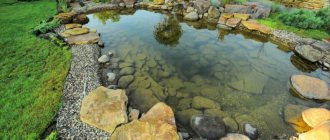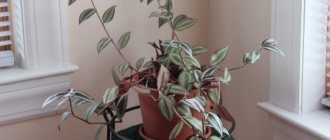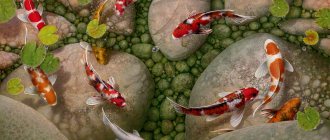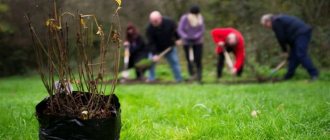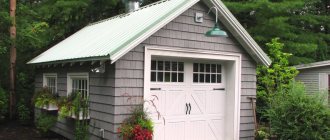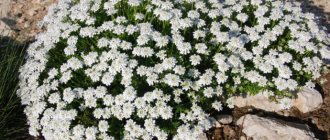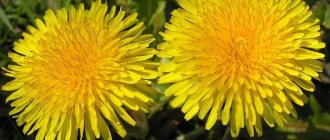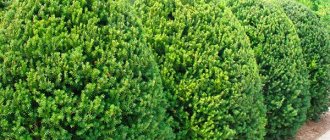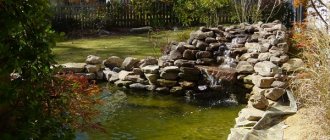Monetary loosestrife
Perhaps loosestrife is not the most obvious choice for an artificial pond on the site, because essentially it cannot be classified as an aquatic plant. However, this groundcover perennial loves moist areas, so it is perfect for planting along the coast.
Long creeping shoots with round coins of rich green leaves create a pleasant contrast against the background of dark, wet stones. And during flowering, the green mat is covered with bright yellow flowers.
Monetary loosestrife is completely unpretentious: you can plant it and virtually forget about its existence! It is frost-resistant and does well near water.
By the way, this plant is edible. Herbal tea was made from it. A natural yellow dye was also obtained from the leaves.
Deep-sea plants for a decorative pond
Representatives of this group are: marsh flower, egg capsule, aponogeton and the queen of ponds - water lily or nymphea.
Many people create ponds in their garden just because they really want to grow water lilies. We purchase large water lilies from the nursery of Alexander Marchenko. They are sold in large pots containing food for 2-3 years. The water lily is a “glutton”; it requires a lot of nutrients. It is irrational to plant them in the ground, because for optimal growth and development in winter and summer it must be at different depths. To overwinter well, it needs 90 cm (in the conditions of the Moscow region), and to grow and bloom better - 60 cm. When a water lily is planted in a container, it is very easy to move it around a pond. In addition, water lily rhizomes planted in the bottom soil quickly grow, and the plants occupy the entire reservoir.
nymphea or water lily in a decorative pond
After 3 years, container water lilies need to be replanted, otherwise they will become smaller and bloom poorly. Procedure:
- remove containers with water lilies from the pond;
- cut off the top layer with rhizomes;
- assess how the plant can be divided, taking into account the number of awakened buds;
- cut the layer into several parts and plant them in separate containers (the rhizomes are not buried in the ground, but placed on the surface so that they do not float up, tied with garden wire);
- Attach a wire handle to the container to move it along the pond from the shore without falling into the water.
Kubyshka
Capsule is a nice aquatic plant that not only decorates, but also cleanses the pond. If you are afraid that the water in your pond will bloom, plant a capsule there and consider that the problem is solved.
Like many unpretentious plants, it grows quite quickly. Therefore, thickets of egg capsules need to be regularly thinned without sparing.
Find out more about growing this plant in our article:
- Yellow egg capsule - is it difficult to grow in a pond?
What is the care of the egg capsule and how to propagate it.
The beauty of freshwater plants
Plants of fresh water bodies, photos of which can be seen in this article, continue to amaze with their beauty. For example, seeing a white water lily in a pond, few will remain indifferent to its grace. Her flowers are big and large.

Opening at sunrise, they close only at sunset. Among the people, the water lily received several names, among which the most famous are white lily and water rose. Its leaves, located above the water, are large and large. They are characterized by the presence of a large number of air cavities, but their underwater leaves look like ribbons. Often in freshwater bodies of water you can find an equally beautiful yellow water lily.
Plants and animals of fresh water bodies are unique and require constant protection. Thanks to constantly changing climatic conditions, some of them are on the verge of extinction, while the rest have significantly reduced their population. The only exception is the amphibious buckwheat, which, when the reservoir dries out, sheds aquatic leaves and grows new ones, characteristic of a land plant.
However, in contrast to the amphibious buckwheat, we can give the example of pondweed, which grows exclusively at great depths and is a favorite place for laying eggs by most fish. It is imported into some imported farms specifically in order to significantly increase the fish population.
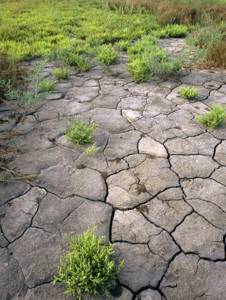
A person should try with all his might to maintain the ecological situation of freshwater bodies of water, reducing harmful emissions not only into water sources, but also into the atmosphere, and also, as far as possible, reduce the population of various plants that reduce the moisture content in water bodies and ultimately lead to their complete drying.
Water lilies
Water lilies, or nymphs, are classic aquatic plants. Many gardeners decide to set up an artificial pond on their property just to have water lilies on their property.
These flowers delight with a variety of inflorescence color options: among them there are white, yellow, pink, orange, green, and even blue and purple.
- Nymphea - the best varieties with photos, planting and care
Everything you wanted to know about growing water lilies.
Winter-hardy types of nymphs include white water lily, tetrahedral water lily, fragrant water lily, pure white water lily, and knobby water lily.
Rivers and lakes
Plants of fresh water bodies, which are characteristic of river and lake areas, are primarily noticeable on the banks. This is primarily characteristic of iris flowers, which are similar in appearance to ordinary garden iris. In addition to them, the no less common weeping grass can grow in the coastal zone, whose purple inflorescences, reminiscent of a spike, immediately catch the eye. Its leaves are similar to willow leaves, but they are characterized by special slots, thanks to which excess moisture that the plant absorbs is easily drained out.
Pistia
Pistia is often colloquially called water lettuce. It can decorate any pond thanks to its rosettes of lime-colored leaves. It really does look like floating heads of lettuce!
Despite the fact that pistia is a beautiful plant, it needs an eye and an eye! It grows rapidly, actively absorbing water from the reservoir, resulting in waterlogging. Of course, only if you don’t tame her in time.
Chinese farmers grow pistia in fish ponds as pig feed. Therefore, this lack of pistia also has a beneficial side. If you have a small farm, it is quite possible to feed excess water lettuce to animals.
The most common plants in freshwater bodies
Plants of fresh water bodies, the names of which are indicated in this article, grow almost everywhere, but have many individual characteristics. As an example, we can cite plants that can be seen almost everywhere where there is fresh water - these are reeds, cattails and reeds.
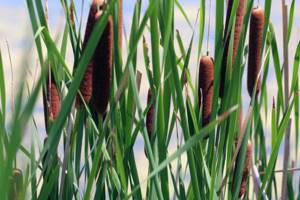
They like to grow in thickets and have many similar features, due to which they are often confused with each other, although they belong to different families. First of all, these are the stems, which in these plants are tall and straight. In some cases they can even reach 6-9 meters, but this is where their similarity ends. In reeds there are practically no leaves on the stem; in cattails, the leaves begin to twist in a helical manner from the base. In addition, the cattail ear is long and velvety, unlike reeds, which are characterized by a fluffy panicle.
Pontederia
Pontederia is a very beautiful plant that will decorate your garden with shiny heart-shaped leaves, and in late summer it will also decorate it with beautiful panicles of white, lavender, and blue inflorescences.
The great advantage of this decorative perennial is that it is an excellent natural filter and is able to purify water and soil.
Pontederia is planted at a depth of 5-10 cm below the surface of the water. In mild climates it winters well without any shelter, but in the middle zone it will most likely freeze out.
Gardeners combat the low winter hardiness of this crop in the following way: they plant pontederia in large container-baskets that do not restrict the horizontal rhizome, place them in water, and with the onset of cold weather, take them out and store them together with other delicate aquatic plants.
An alternative option is to grow pontederia in deep ponds and, with the onset of autumn, move the basket to a depth of at least 1-2 m, where the water will not freeze.
The most common floating plants
On the surface of the water you can often see common watercolor (sometimes called frogweed). It grows rather slowly, although it blooms for quite a long time. It tolerates wintering at the bottom very well. Some gardeners take out the plant buds along with the sludge and store them in a separate container with water. The diameter of the leaves can reach five centimeters, and the height of the flowers is 4 cm. Propagated by division.
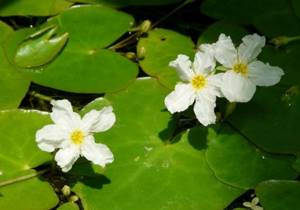
Common watercolor
But you will definitely recognize this “hero”! This plant is considered one of the most common when it comes to arranging artificial reservoirs. Hornwort is a magnificent and recognizable oxygenator. It has no roots and feels great in almost any water. It does not grow very much, it looks like a thick and branchy brush. Be sure to get some hornwort! It will maintain biological balance in the reservoir. There are several types of this plant, but we will recommend you the dark green one.
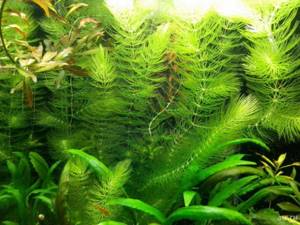
Oxygenator for a pond - hornwort
Horsetail
Horsetail (swamp, riverside, wintering) is a real find for landscaping ornamental ponds! Its main advantage is its bamboo-like stems, which will surround the pond with a spectacular green fence.
They plant it on the shore of a reservoir, but it is not afraid of going a little deeper into the water - in it the horsetail feels like it is in its element.
As popular wisdom says, beauty requires sacrifice. And this is true in landscape design too! Horsetail is decorative, but can act like a real invasive species: at the end of summer, cut the stems back to the ground to prevent the spread of spores. And don’t be afraid to thin out your plantings.
Can you boast of having a decorative pond on your site? Share your photos with us in the comments to this article!
Coastal decor
Plants are planted not only in the pond itself, but also near it. This is done to create a smooth transition between the coastal area and the rest of the garden. Shrubs, herbs, deciduous trees and pine needles are planted around the pond. Usually they do this: trees are planted farthest from the pond, shrubs are planted in front of them, and herbs and flowers are planted near the water itself. This is done so that tree leaves do not clog the decorative pond and you do not have to clean it too often.
Deciduous trees
Such trees should have a beautiful, graceful shape and delicate leaves. In addition, they should be low so as not to obscure the water surface:
- Walker (caragana tree). This plant can be small in size if it is properly grafted. It has straight shoots, and the branches hang down under the weight of the leaves. In addition, the tree tolerates frost well.
- Pendula (shaggy plum). A small tree that grows very slowly. It has an umbrella-shaped crown and branches hanging down. The crown diameter is from 3 to 4 m. During flowering, it is covered with unusually beautiful pink flowers.
- Pendula (purple willow). Grafted onto a standard. From a distance it looks like a small shrub with arched shoots, but in reality it is a small tree.
- Carly Locks (goat willow). Also grafted onto a standard. A small tree with twisted branches hanging down to the ground.
- Camperdown (slippery elm). A small tree with a spreading umbrella-shaped crown. The branches and leaves are “weeping” and hang downwards. If the crown is not trimmed, its diameter can be up to 10 m.
Needles
Coniferous trees for planting around a pond, like deciduous trees, must have a weeping crown in order to look harmonious near the water. So, what coniferous trees are planted near reservoirs:
- European larch varieties Kornik, Repens and Puli. All varieties are grafted onto a standard. They have a weeping spherical crown. The needles are soft and fall off in the winter.
- Inversa (spruce). Weeping tree, branches drooping. As a rule, it grows very slowly, although this depends on the method of gartering.
- Pendula (Canadian hemlock). The height of the tree also depends on the grafting. The branches spread along the ground. The needles are soft and pleasant to the touch.
- Jeddeloch (Canadian hemlock). Over the course of 10 years, the tree grows to only 0.5 m. It has a small spherical crown. Perfectly protects the area from the wind.
Shrubs
Shrubs are planted in front of the trees to complement the landscape:
- Dwarf birch. The shrub is very small in size. It reaches a height of 0.5 to 1 m. It grows up to 1 m in width. It has a dense nest-shaped crown.
- Black Lace (black elderberry). This shrub grows up to 3 m tall. It has beautiful carved leaves of an unusual purple hue. During the flowering period it is covered with small pink flowers. Not too demanding and capricious, it can be easily cut.
- Hydrangea. These flowers will decorate the coastal area. Choose any variety from the following: Bella Anna, The Original, Limelight, Magical Fire, Grandiflora, Twist-n-Shout. They will delight you with their ease of care and a variety of colors of various shapes and colors.
Shrubs complement the landscape well
Herbs
But the area near the shore is decorated with coastal herbs and flowers. Let's look at them in more detail:
- Hosta. An incredibly beautiful and graceful plant that is planted along the shore. The flowering period is extremely short, but during this time it will delight you with beautiful flowers. Reproduces vegetatively. This plant can be damaged by slugs or ducks.
- Day-lily. It blooms with beautiful one-day flowers of various colors - from red to blue. Keep in mind that these plants need full sun, so don't plant them in the shade.
- Lobelia. It is planted directly into the water, not far from the shore. A characteristic feature of the flower is its pale blue inflorescences, which will give the pond a charming appearance.
- Ostrich. A variety of fern. Used to make an artificial pond look more like a real one. Looks like large bird feathers. Propagated by dividing the bush.
- Volzhanka. Decorate the shore of the pond with cream-colored flowers. Please note that Volzhanka grows up to 2 m in height. It is often used to create shadow.
Advantages and disadvantages of an artificial pond
And in conclusion, I want to talk about the main disadvantages and advantages of a plastic pond, which I can confirm from my own experience.
The main disadvantages of a plastic reservoir-bowl
- No matter how hard a gardener tries, plastic garden ponds will always look a little unnatural.
- In an artificial reservoir-bowl it is more difficult to create biological balance.
- Plastic ponds are not very durable and will require replacement over the years.
- Usually, the bowls do not have sufficient depth and exclude the possibility of wintering nymphs and fish.
- A ready-made basin-bowl eliminates the possibility of using a creative approach to shape.

We installed a plastic pond in the garden 7 years ago. Lyudmila Svetlitskaya
Pros of a plastic pond
- Easy and quick installation of the finished bowl.
- Availability (can be easily purchased at any garden store or supermarket department).
- Wide selection of different configurations and sizes.
- The structure has steps on which coastal plants can be placed.
- Possibility of self-installation without the involvement of hired labor and unnecessary financial costs.
Planting and caring for vegetation in the pond
Plants are planted in and around the pond only when the structure is completely completed and filled with water. It is important that the water sits for at least 10 days. Moisture-loving crops are planted in early summer. Depending on the type of plant, it is located directly in the pond or near it. Deep-water crops are planted at the bottom of the pond, and it is better to do this in pots with holes all over the surface so that the roots do not rot in the future. It is much easier to care for crops in pots, or rather, move them to a warm place for the winter and move them as needed.

It is imperative to ensure that the soil in baskets and pots is protected from erosion and does not cause cloudiness to rise from it. To do this, already installed pots with plants are covered with a layer of burlap, on which there are small pebbles.
Regardless of the type of pond plant, it is important to remove all old leaves and long roots before planting. It is necessary to clarify in advance at what depth in the soil the plant’s roots should be. The crops are not planted close to each other, but so that each shoot has enough space and light for normal growth.

We take care of the plantings
It is not enough to simply plant plants in and around the pond. To enjoy a beautiful view, you need to properly care for everything that was planted. It consists of constant thinning, during which old, dead and overgrown shoots and leaves are removed.

As for wintering, those aquatic plants that grow in a given climate can be left in the pond, since this is their usual environment and they are ready for such conditions. But exotic crops from the pond will have to be moved to a warm place. An aquarium or bathtub is suitable as a reservoir for them, but only located indoors. Before immersing in a new place, the roots of such plants are cut off. It is important to remember that it is necessary to maintain sufficient lighting in the room, thanks to which the flora representatives will not wither away.

Features of wintering aquatic plants
It must be remembered that small garden or country ponds, created with your own hands using containers built into the ground, are subject to freezing in winter.
In order to save plants from freezing in winter, they must be moved for wintering to specially prepared places for this purpose, namely:
- plants growing in baskets are moved to a warm room (basement or other frost-free room), into a container with water, providing water supply;
- free-floating plants are moved to a warm aquarium or other container suitable for this purpose.
Rules for planting aquatic plants
Let's look at the main points:
- The preferred option for planting aquatic plants is container planting or mesh baskets.
- The most favorable time for planting aquatic plants is late spring - early summer.
- When preparing the soil for planting, you need to mix clay and peat in a 2/1 ratio, add fertilizer and mix, moisten with water.
- Pour the prepared soil into the bottom of the container (basket).
- Place the plant in a container (basket), after removing dry and dead leaves and other parts from it.
- Straighten the root system of the plant, distributing it evenly throughout the container (basket).
- Carefully fill the plant with soil up to the root collar and compact the soil around it well.
- Cover the top of the soil with pebbles about a couple of centimeters high, then you can put larger decorative stones.
- In order to make it convenient to lift or release the container (basket) into the pond, attach a fishing line to it in 3-4 places.
- Carefully release the container (basket) into the water so as not to disturb the plant and soil; first, do not lower the container (basket) deeply (bring the ends of the fishing line to the shore, decorating them with any object convenient for you).
Decorating an artificial pond
The most long-awaited and pleasant moment comes after all technical work is completed, when you can give free rein to your imagination and begin decorating the banks of the bowl with decorative stones and planting plants.
The most difficult task that a gardener faces at this stage is to hide the unsightly plastic edge of the container protruding above the ground. Usually, two methods are used for this purpose: they cover the perimeter of the bowl with decorative stone or plant creeping carpet perennials, which, as they grow, cover the plastic with a living green carpet.
Sometimes both methods are used together. It is most natural when part of the shore is covered with plants, and the other part is decorated with stones, as is often the case in nature.
As for decorating the coastline with stone, for these purposes, most often, they use rocks that have a flat shape, for example, slate or flagstone
To hide the plastic edging of the pond, it is important to place the stones directly on it, but in this case they will stand unevenly and unstable (due to the fact that the edges of the pond usually rise above the soil)
To avoid this, you can make a concrete base-formwork around the pond, into which decorative stones are placed. But if your plans do not include a permanent design of the coastline, then you can even out the difference by placing pieces of slate, crushed stone or broken bricks under the stones. It looks very beautiful if some stones hang quite strongly over the surface of the water, while others slightly recede from the water and are covered with coastal vegetation.
Some summer residents use decorative pebbles glued to a mesh to decorate the edges of a plastic pond. You can buy similar “rugs” in large supermarkets in the bathroom tiles department.
This option is quite acceptable, but before purchasing it is important to make sure that the manufacturer used waterproof glue
Often the soil that remains after digging a hole for a pond is used to build high banks, on which something like an alpine slide is then built. Aesthetically, this technique looks good. But as soon as you start watering the newly planted plants, waterfalls of mud will flow straight into the pond
To avoid this, it is important to build slides away from the edge of the pond. In the future, the slopes are strengthened with the help of ground cover plants (for example, sedums), then this problem can be forgotten

Be sure to make a paved area near one of the banks to provide access to the water. Lyudmila Svetlitskaya
